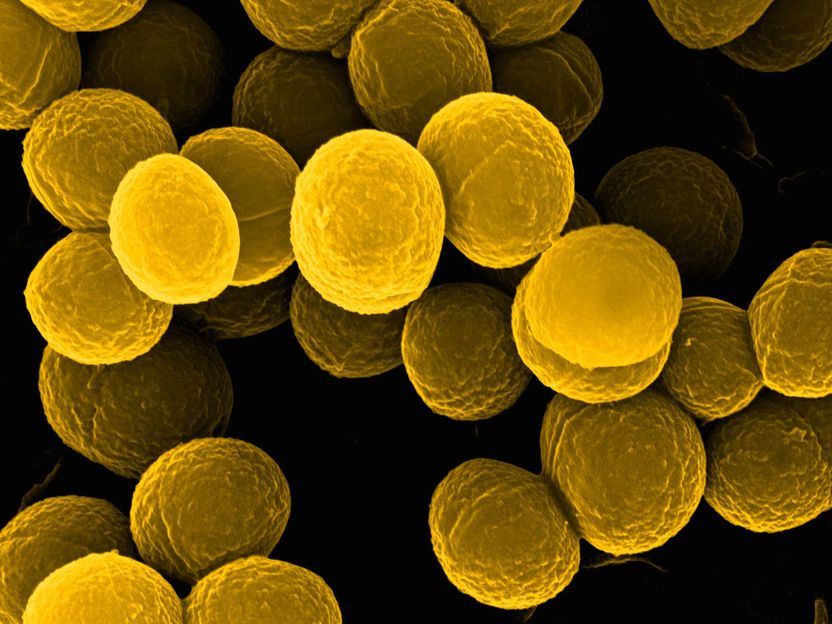A bright spot for microbiological diagnostics
Researchers develop molecular probes to detect pathogens in clinical samples
The detection of bacterial pathogens in clinical samples is an important prerequisite for successful antimicrobial treatment. A team from the Helmholtz Centre for Infection Research (HZI) in Braunschweig, the German Center for Infection Research (DZIF) and Tel Aviv University, Israel, has now developed molecular probes that can detect different bacterial species with high sensitivity. Bacterial cells activate the probes and make them glow. This signal enables pathogen detection directly in clinical samples. The results were published in the journal Angewandte Chemie.

Electron micrograph of Staphylococcus aureus, one of the pathogens that the new probes can detect.
HZI/Manfred Rohde
In view of the increasing threat by antibiotic resistances, diseases should not be treated with antibiotics on suspicion. Antibiotic stewardship therefore requires prior verification that a bacterial infection is indeed present. However, microbiological methods, in which the pathogens are cultivated on growth media, take time and are often not successful if patients have already been treated with antibiotics, for example. Improved diagnostics therefore constitutes an important component in the fight against antibiotic resistance.
A research team led by Prof Mark Brönstrup from the Helmholtz Centre for Infection Research (HZI) now wants to contribute to this with novel probes. The researchers are making use of a class of molecules that bacteria use to sequester iron-containing compounds – the siderophores. “Iron is a scarce resource in the body. Therefore, bacteria also take up siderophores that are not exactly identical chemically to those they produce themselves,” says Carsten Peukert, PhD student in the Department “Chemical Biology” at HZI and first author of the study. “This predestines siderophores for use as molecular Trojan horses.” The researchers coupled a dioxetane molecule to natural or synthetic siderophores. Dioxetane-related molecules are also responsible for the characteristic glow in fireflies. An external light source is not necessary for this. However, to ensure that the probes only light up in presence of bacteria, the researchers integrated a molecular light switch. This is activated when bacteria enzymatically cleave the probes in their cells.
The research team can detect all ESKAPE pathogens with its probe. The term covers the pathogens Enterococcus faecium, Staphylococcus aureus, Klebsiella pneumoniae, Acinetobacter baumannii, Pseudomonas aeruginosa, and Enterobacter species. These pathogens are considered typical representatives of hospital germs and are frequently resistant to antibiotics. “Especially Gram-negative bacteria such as Pseudomonas or Klebsiella, which have two cell membranes, could not be reliably labelled with the precursors of our probes until now. We have now further developed the system so that this group can also be detected,” says corresponding author Mark Brönstrup, head of the Department “Chemical Biology” at HZI and a scientist in the DZIF research area "Novel Antibiotics". The probes can also detect bacteria that multiply inside host cells. The technical requirements for the detection of the probes in clinical material such as blood plasma are comparatively low. Therefore, the system could also be used outside specialised laboratories in the future.
Alternative molecular diagnostic methods such as mass spectrometry or the polymerase chain reaction do not distinguish between dead and living bacterial cells. “Our method offers the advantage that only living bacteria are detected. So when the probes light up, there is an active infection,” says Brönstrup. In addition to use in clinical samples, he says, use in food hygiene is also conceivable. Moreover, the siderophore-based system can also be adapted to deliver antimicrobial agents instead of the luminescent probes. The bright spot for diagnostics is thus only the beginning of the applications for the molecular Trojan horses of the HZI researchers.
Original publication
Carsten Peukert, Sachin Popat Gholap, Ori Green, Lukas Pinkert, Joop van den Heuvel, Marco van Ham, Doron Shabat, Mark Broenstrup: Enzyme-activated, Chemiluminescent Siderophore-Dioxetane Probes Enable the Selective and Highly Sensitive Detection of Bacterial ESKAPE Pathogens. Angewandte Chemie International Edition, Mai 2022.
Other news from the department science
Most read news
More news from our other portals
See the theme worlds for related content
Topic world Diagnostics
Diagnostics is at the heart of modern medicine and forms a crucial interface between research and patient care in the biotech and pharmaceutical industries. It not only enables early detection and monitoring of disease, but also plays a central role in individualized medicine by enabling targeted therapies based on an individual's genetic and molecular signature.

Topic world Diagnostics
Diagnostics is at the heart of modern medicine and forms a crucial interface between research and patient care in the biotech and pharmaceutical industries. It not only enables early detection and monitoring of disease, but also plays a central role in individualized medicine by enabling targeted therapies based on an individual's genetic and molecular signature.




















































